
Flounders are a group of flatfish species. They are demersal fish, found at the bottom of oceans around the world; some species will also enter estuaries.

Long Island Sound is a tidal estuary of the Atlantic Ocean, lying predominantly between the U.S. state of Connecticut to the north, and Long Island in New York to the south. From west to east, the sound stretches 110 mi (180 km) from the East River in New York City, along the North Shore of Long Island, to Block Island Sound. A mix of freshwater from tributaries and saltwater from the ocean, Long Island Sound is 21 mi (34 km) at its widest point and varies in depth from 65 to 230 feet.
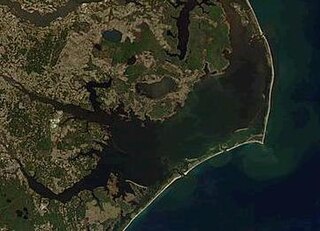
Pamlico Sound in North Carolina in the US is the largest lagoon along the North American East Coast, extending 80 mi (130 km) long and 15 to 20 miles wide. It is part of a large, interconnected network of lagoon estuaries that includes Albemarle Sound, Currituck Sound, Croatan Sound, Pamlico Sound, Bogue Sound, Core Sound, and Roanoke Sound. Together, these sounds, known as the Albemarle-Pamlico sound system, comprise the second largest estuary in the United States, covering over 3,000 sq. mi. of open water. The Pamlico Sound is separated from the Atlantic Ocean by the Outer Banks, a row of low, sandy barrier islands that include Cape Hatteras National Seashore, Cape Lookout National Seashore, and Pea Island National Wildlife Refuge. The Albemarle-Pamlico Sound is one of nineteen great waters recognized by the America's Great Waters Coalition.
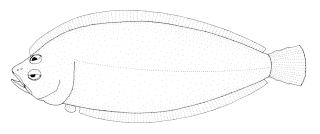
The southernflounders are a small family, Achiropsettidae, of flounders found in Antarctic and sub-Antarctic waters. There are four genera, each with one species.

The Thames Estuary is where the River Thames meets the waters of the North Sea, in the south-east of Great Britain.

Pleuronectidae, also known as righteye flounders, are a family of flounders. They are called "righteye flounders" because most species lie on the sea bottom on their left sides, with both eyes on their right sides. The Paralichthyidae are the opposite, with their eyes on the left side. A small number of species in Pleuronectidae can also have their eyes on the left side, notably the members of the genus Platichthys.

The starry flounder, also known as the grindstone, emery wheel and long-nosed flounder, is a common flatfish found around the margins of the North Pacific.
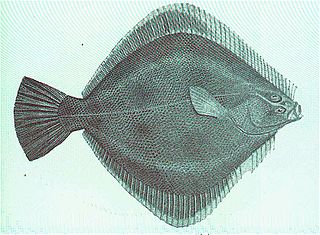
The New Zealand sand flounder is a righteye flounder of the genus Rhombosolea, found around New Zealand in shallow waters down to depths of 100 m.
The banded-fin flounder or spotted flounder, Azygopus pinnifasciatus, is a righteye flounder and the only species in the genus Azygopus. It is found off southern Australia and New Zealand, on the continental slope at depths of between 120 and 900 m. Its length is up to 20 cm (7.9 in).

The winter flounder, also known as the black back, is a right-eyed ("dextral") flatfish of the family Pleuronectidae. It is native to coastal waters of the western north Atlantic coast, from Labrador, Canada to Georgia, United States, although it is less common south of Delaware Bay. It is the most common near-shore (shallow-water) flounder in the waters from Newfoundland down through Massachusetts Bay, reaching a maximum size around 61 cm in length and 2.25 kg in weight. The species grows larger on Georges Bank, where they can reach a length of 70 cm and weight of 3.6 kg. Although winter flounder historically supported large commercial and recreational fisheries, biomass and landings have decreased since the 1980s.
The Antarctic armless flounder(Mancopsetta maculata) is a species of southern flounder found on subantarctic shelves, around Antarctic islands, and banks off East Antarctica. This species can grow to a length of 50 centimetres (20 in) SL. It lives in depths of from 100 to 1,115 metres.
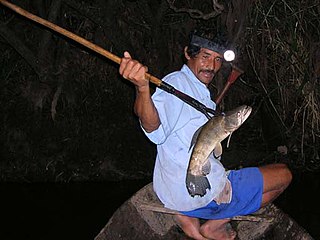
Gigging is the practice of hunting fish or small game with a gig or similar multi-pronged spear. Commonly harvested wildlife include freshwater suckers, saltwater flounder, and small game, such as frogs. A gig can refer to any long pole which has been tipped with a multi-pronged spear. The gig pole ranges in length from 8 to 14 feet for fish gigs and 5 to 8 feet for frog gigs. A gig typically has three or four barbed tines similar to a trident; however gigs can be made with any number of tines. In the past people would attach illuminated pine knots to the end of gigs at night to give them light.

The summer flounder is a marine flatfish that is found in the Atlantic Ocean off the East Coast of the United States and Canada. It is especially abundant in waters from North Carolina to Massachusetts.
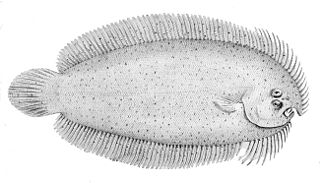
Ammotretis is a genus of righteye flounders native to the coastal waters off southern Australia.
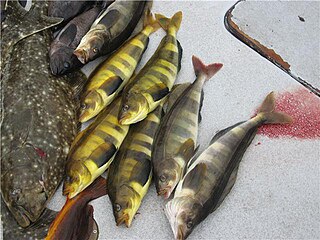
The Atka mackerel is a mackerel in the family Hexagrammidae. Atka mackerel are common to the northern Pacific ocean, and are one of only two members of the genus Pleurogrammus - the other being the Arabesque greenling. The Atka mackerel was named for Atka Island, the largest island of the Andreanof islands, a branch of the Aleutians.
Pseudomancopsetta andriashevi, the Pygmy flounder, is a species of southern flounder known from deep waters off of the southern coast of Chile as well as from around the Crozet Islands and Prince Edward Islands where it occurs at depths of from 200 to 365 metres. This species grows to a length of 11 centimetres (4.3 in) SL. This species is the only known member of its genus.
The Burdwood Bank, called Namuncurá in Argentina and other countries, is an undersea bank with a prominence of approximately 200 m, part of the Scotia Arc projecting some 600 km (370 mi) from Cape Horn in the South Atlantic Ocean and located some 200 kilometres (120 mi) south of the Falkland Islands. Argentina claims economic rights over the whole of the bank, while the United Kingdom has designated about half of the bank as part of the Falklands Outer Economic Zone.

The eyed flounder is a species of fish in the family Bothidae. The species is found on or near the sandy seabed in relatively shallow waters in the western Atlantic Ocean, the Caribbean Sea and the Gulf of Mexico.

The Gulf Stream flounder is a species of fish belonging to the family Paralichthyidae native to waters off eastern North America.













